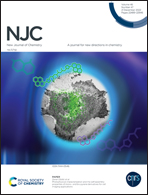Incorporation of a Z-scheme AgI/Ag6Si2O7 heterojunction to PET fabric for efficient and repeatable photocatalytic dye degradation†
Abstract
A novel AgI/Ag6Si2O7/PET Z-scheme heterojunction photocatalyst with strong redox capability was fabricated via a facile successive ionic layer adsorption and reaction (SILAR) method to degrade methyl orange (MO). Compared with Ag6Si2O7/PET and AgI/PET, the prepared AgI/Ag6Si2O7/PET heterojunction exhibits superior photocatalytic performance under visible light because of its strong interfacial coupling effects. The degradation rate constant of the optimal AgI/Ag6Si2O7/PET is up to 0.144 min−1, which is approximately 5.5 and 9.6 times greater than that of Ag6Si2O7/PET and AgI/PET, respectively. The radical capture experiments and ESR characterization demonstrate that h+ and ˙O2− are two major oxidative species responsible for the photocatalytic degradation of dyes. The PL, photocurrent and EIS analyses indicate that AgI/Ag6Si2O7/PET shows enhanced electron–hole pair separation efficiency. This phenomenon is related to three aspects, namely the high light-harvesting efficiency, greatly enhanced accessibility to the active site, and the formation of Z-scheme heterojunction structures that effectively improve the photoelectron–hole separation efficiency and the redox capacity of the photocatalyst. Our work, therefore, provides novel insights into the development of a heterojunction composite with boosted photocatalytic activity, excellent stability, and reusability for the degradation of organic pollutants.



 Please wait while we load your content...
Please wait while we load your content...